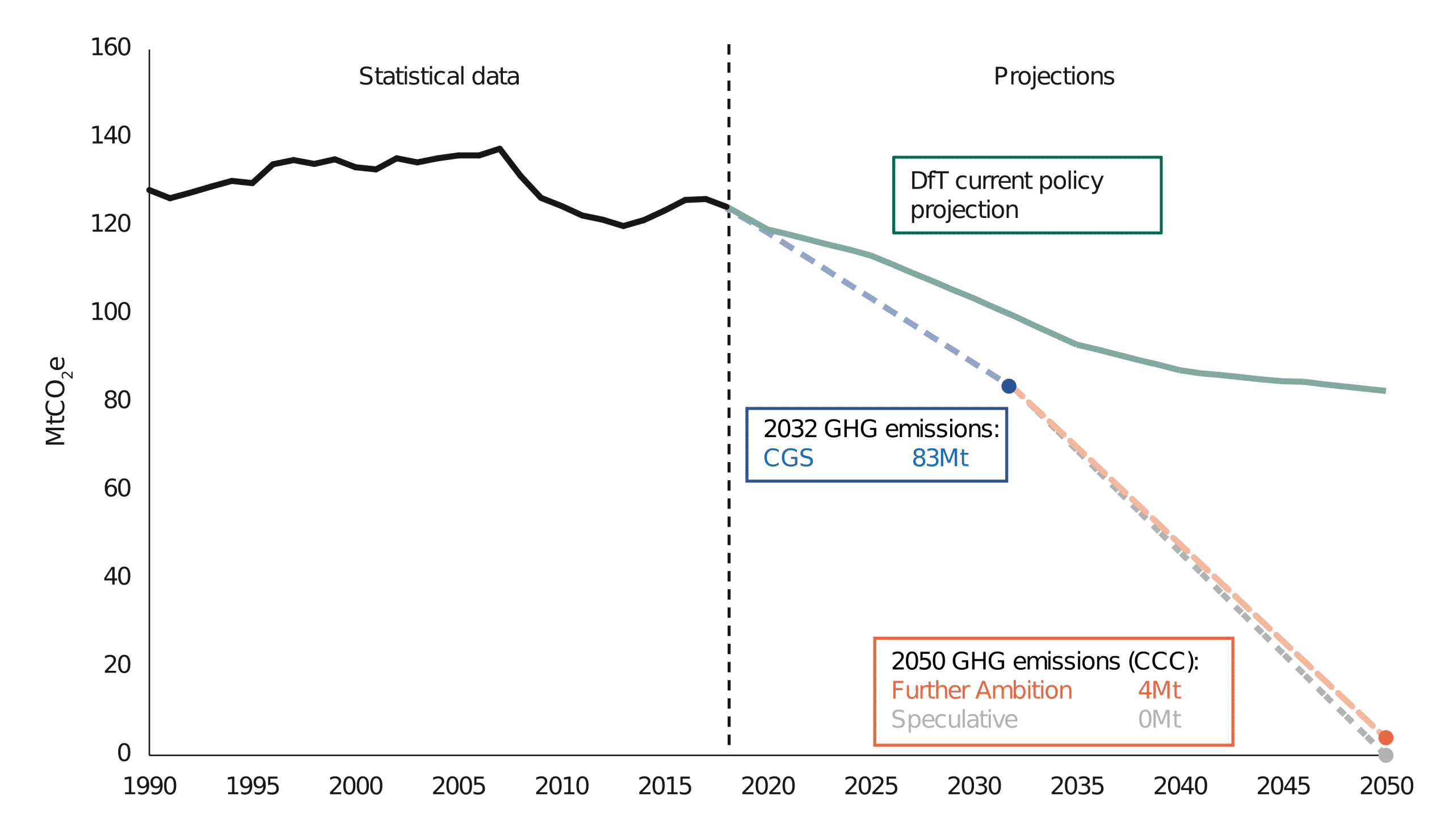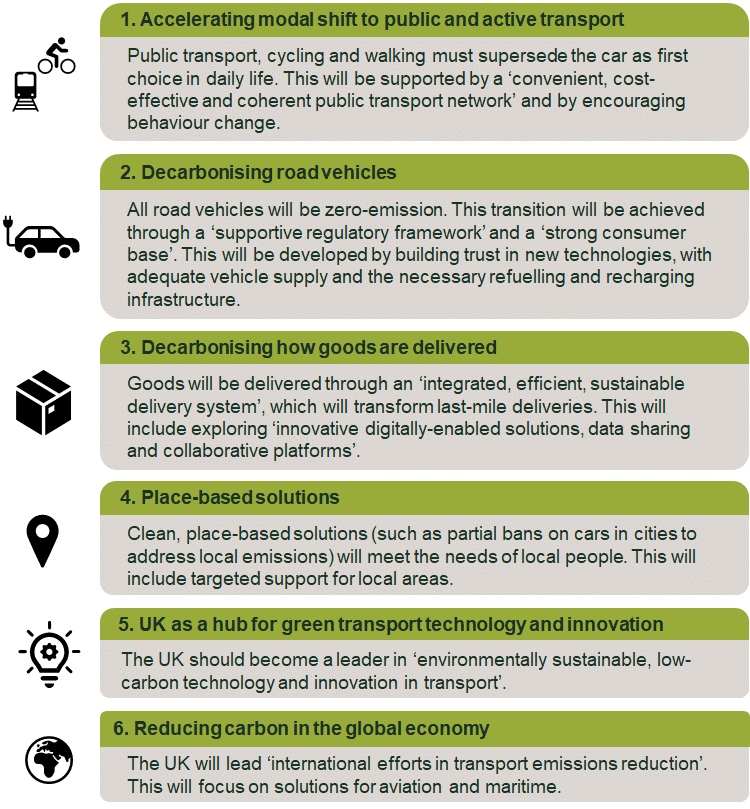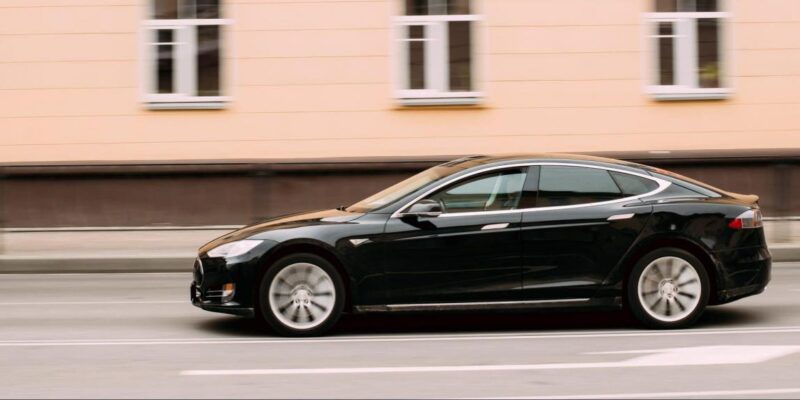Decarbonising transport: a just transition?
In March, the UK Department for Transport (DfT) published ‘Decarbonising Transport: Setting the Challenge’, a policy paper outlining current and planned policies needed to decarbonise the UK’s domestic transport sector. We provide a commentary on some of the DfT’s strategic priorities—the shift to active and public transport, as well as the decarbonisation of the passenger vehicle fleet. We then discuss some of the wider social implications raised by the proposed measures.
In 2019, the UK became one of the first major global economies with a net zero climate goal.1 In 2018, the transport sector accounted for 28% of the UK’s domestic greenhouse gas emissions, the highest share across all sectors of the economy.2
The DfT’s policy paper considers the implications of the decarbonisation challenge for transport policy. Its full Transport Decarbonisation Plan 2020 is scheduled to be published in the autumn.
This article first summarises the six strategic priorities set out by the DfT in its policy paper. It then provides a commentary on the first two priorities, focusing in particular on the economic and social implications of some of the proposed measures.
The decarbonisation challenge
The current trajectory
The DfT currently projects that, under existing expenditure and regulation (i.e. excluding future policies), domestic transport greenhouse gas emissions will fall, but that the speed of reduction will be too slow to reach zero emissions by 2050.3 Figure 1 below illustrates the discrepancy between the DfT’s projection and the scenarios set out by the UK government’s 2017 Clean Growth Strategy and the UK Committee on Climate Change.
Figure 1 Greenhouse gas emissions from domestic transport

Source: Department for Transport (2020), ‘Decarbonising Transport: Setting the Challenge’, March.
The DfT recognises that major interventions, and a cross-modal approach, are needed to reach the zero emissions target—and that reaching zero will require significant changes in people’s behaviours. As shown in Figure 2 below, six strategic priorities are identified by the DfT for achieving a decarbonised transport network by 2050.
Figure 2 The DfT’s six strategic priorities

A number of these strategic priorities involve, in some way, reducing total emissions from cars.
Reducing emissions from passenger cars
In the UK, cars are the most common mode of transport regardless of journey purpose,4 and make up the biggest source (55%) of domestic transport emissions.5 Emissions from cars are influenced by both the total distance driven, and the emission intensity of this distance.
Therefore, to discuss the economic and social implications of the DfT paper, we focus on the first two strategic priorities:
- the modal shift from passenger cars to active and public transport, which has an impact on the total distance driven;
- the decarbonisation of the passenger car fleet, which influences emission intensity.
A shift away from cars and towards more active and public transport
Given the high share of domestic emissions from cars, the need to shift away from cars to public transport (e.g. bus, rail, metro and tram) and active transport (e.g. cycling and walking) is a key announcement.
In 2018, 58% of car journeys were under five miles,6 suggesting that a high proportion of car journeys could potentially be undertaken by public transport, and by active transport in particular. This could lead to further benefits to society in terms of health and wellbeing (through both reduced air pollution and a more active population) and reduced congestion (which would in turn help public transport to become more efficient).
Buses and bikes
Buses have a key role to play in reducing emissions, through using zero-emission technology (and being far more efficient for many journeys than cars). Many cities (including London) have already pledged to procure only zero-emission buses from 2025, while others outside of the UK (such as Amsterdam and Copenhagen) have gone further and will fully transition by 2030 or earlier.7
A key question when it comes to all forms of public transport relates to funding and determining who will pay (whether it is the user, the taxpayer or some other form of beneficiary—e.g. those who benefit through land value capture). The DfT paper does not address this in any detail.
The DfT estimates that committed spending on active travel could reduce total car use in England by around 0.9% in 2020.8 It intends to establish a £350m Cycling Infrastructure Fund to encourage active travel, and will create a long-term programme and budget to increase investment in cycling and walking.9 Given that the government states that its aim is to double cycling activity, it is surprising that the paper does not mention e-bikes, which can make cycling more accessible. E-bikes also have the advantage of causing less congestion as well as using fewer resources in the production process than other electric vehicles (EVs).10
The DfT also emphasises that changes in behaviour will be required in order to achieve a modal shift. In the short run, COVID-19 has led to a reduction in the number of journeys and an increase in active travel.11 While it is yet to be seen which of these new behaviours will persist in the longer term, many major cities (including London)12 have announced new investments in active travel and measures such as closing roads to cars and widening cycle lanes.13
However, while these changes are a step in the right direction (with regard to active travel), there is a considerable challenge in encouraging public transport given social distancing requirements, with many people (outside of London) stating that they will be more likely to switch to driving over bus or rail once travel restrictions are lifted.14
Disincentivising car use
The recent changes introduced in major cities around the world (as a result of the COVD-19 pandemic) are a first step in challenging the dominance of the car. However, outside of urban centres, cars and vans have high modal share as there are fewer public transport services, fewer constraints on car use and longer distances to employment and services, all of which make car ownership more attractive.15
These challenges highlight that significant changes are needed in order to shift people away from car use. Investment in public transport is clearly one part of the solution. Another potential lever (not addressed in the DfT paper) would be to reform fuel taxation in order to reverse the decline in fuel duty.16 Increasing fuel costs would give incentives for reduced fuel usage (either through making fewer journeys or using more fuel-efficient vehicles). More generally, a system of transport pricing that internalises the external costs associated with car usage (such as a nationwide road pricing scheme) could encourage a shift away from the car.
Decarbonisation of the vehicle fleet
The DfT’s current policy scenario projects that the number of car kms travelled will increase by 35% between 2018 and 2050,17 mainly due to population growth.18 Consequently, while encouraging public and active transport will be an important part of the decarbonisation plan, reaching zero emissions will inevitably also rely on decarbonising the vehicle fleet.
The DfT paper focuses mainly on EVs, although hydrogen is also mentioned as an option, in particular for larger vehicles. However, major barriers to the widespread adoption of EVs remain, including financial barriers; the need for behavioural change; a lack of charging infrastructure; and regulatory barriers.
EV uptake and incentives
Consultation is currently under way to bring forward the end to the sale of new petrol and diesel vehicles from 2040 to 2035 or earlier.19 This is an essential incentive for manufacturers to invest in EVs.
In addition, the UK government currently offers grants for plug-in vehicles, funding for charging infrastructure at home, at workplaces, on residential streets and wider road networks, and incentives for private investment in charging points. These measures are a mix of removing barriers to the use of EVs (the lack of charging points) and providing financial support (grants, which lower the cost of acquisition).
Despite these measures, uptake in the UK has been slow. DfT analysis shows that a large proportion of the registered ultra low-emission vehicles have made use of the plug-in grant. However, in 2019, only 3% of new cars sold were ultra low-emission20—the high acquisition cost of EVs is likely to act as a significant barrier to more widespread uptake, and therefore a range of additional incentives are needed to further encourage this.
While financial incentives are important, they may not be sufficient on their own to change behaviours. Even if there are no important ‘physical’ barriers, people have a tendency to naturally conform to their habits or previous actions (known as ‘inertia bias’). This is compounded by barriers to adopting EVs, such that even stronger behavioural change will be needed to increase their use. Consumer education and nudges (i.e. making it easier to use an electric car, for example by opening up car pool lanes to allow single-occupant EVs) could therefore play a valuable role in making them more widespread. The DfT’s paper mentions planned incentives regarding charging aimed at removing some barriers, including facilitating payment at charging points; making data on the charging network available; and supporting roaming across different charging networks.
Supportive cross-sectoral regulation
An essential element in creating a sufficient network of charging points is supportive and consistent regulation across different sectors of the economy. Beyond the financial incentives explained above, regulation can support the expansion, ease of use and functioning of the charging network. Various areas of regulation touch on charging points, some of which are mentioned in the DfT’s paper:
- requirements to install charging points: measures such as requiring charging points in all new homes with a parking space or in all offices can increase the size of the network, while smart requirements for charging points optimise energy use;
- regulation of new and existing charging providers: regulation has the potential to facilitate the entry of new charging providers. Common standards can create interoperability and facilitate switching across providers;
- incentives for electricity distribution network operators (DNOs): DNOs can support the development of a charging network by making the necessary infrastructure investments at the right time.
These are regulatory issues that span across sectors, and it will be important for the DfT to coordinate with other regulators and policymakers to create a coherent regulatory environment that supports the creation of charging points.
Social implications
The DfT document includes many aspirations and, while the ambition set out in the paper is urgently needed, a lot of work will be required to decarbonise the UK transport network in reality. More detailed questions need to be grappled with and answered in the coming months and years.
Many of the measures to encourage modal shift and to decarbonise the vehicle fleet have wider social implications that will need to be considered in the development of transport policy. These include the following.
- The need for public transport: bus services are disproportionately used by low-income and vulnerable groups, partly because their lack of resources can constrain access to alternative modes of transport.21 People who are reliant on buses find it harder to access key services and large employment centres within a given travel time, so any decline in the availability and frequency of bus services particularly affects this group.22
- Shifting away from the car: while road user charging is seen as inequitable and hits poorer people the hardest, the negative externalities of not restricting car use—such as increased air pollution or road traffic risk—also disproportionately affect disadvantaged people.23 Car ownership is typically lowest among disadvantaged communities, leaving them reliant on walking, cycling and public transport in order to access key services and participate in society.24
- Measures to reduce the most polluting vehicles: low-income populations in rural regions are especially dependent on their cars, and are more likely to own older, more polluting vehicles. Disincentivising measures, such as carbon taxation of fuels or levies to disincentivise the use of polluting combustion engine cars, are therefore likely to affect these populations disproportionately.
- EVs and financial incentives: scrappage schemes take older, more polluting vehicles off the road and/or replace them with newer vehicles. These and other purchase incentives for EVs, such as subsidies, are likely to be insufficient to make EVs accessible to lower-income groups given the purchase price of EVs. One possible way to alleviate this barrier for lower-income households has been implemented in France: an additional scrappage scheme for low-income households is part of the support for the car industry in the COVID-19 crisis.25 A similar reasoning applies to financial support for the purchase of e-bikes. Due to their high cost relative to regular bikes, financial incentives (e.g. through cycle to work schemes) may be needed to encourage uptake—and these could also be targeted specifically at lower-income groups.
- Supporting charging infrastructure for EVs: while many EV users will rely on home-charging for their vehicles, lower-income households are less likely to have access to off-street parking. This therefore creates an additional barrier on top of the purchase price of an EV. Sufficient public and shared charging facilities can contribute to overcoming this barrier.
The most disadvantaged groups in society may therefore face additional challenges in the decarbonisation of the transport network—and practical solutions are required to tackle this. The importance of fairness and avoiding unfair cost burdens in the process of decarbonisation is also highlighted by the Committee on Climate Change’s latest progress report to Parliament.26
The road to driving down emissions
The DfT’s policy paper sets out many aspirations. While this ambition is urgently needed, a lot of work will be required to develop this thinking into practical proposals.
One particularly challenging aspect of the transition to a decarbonised transport network is that many of the policies may affect the least affluent groups in society the most. Careful consideration of the distribution of effects will be an important component of any policy assessments for navigating a fair decarbonisation pathway.
1 Energy and Climate Intelligence Unit (2020), ‘Net zero: the scorecard’, accessed 22 June 2020.
2 Department for Transport (2020), ‘Decarbonising Transport: Setting the Challenge’, March.
3 The DfT’s paper refers to ‘net zero’ emission targets for the transport sector, but does not mention carbon offsets or trading for any sector besides aviation. It therefore appears that the paper is referring to fully decarbonising domestic transport.
4 In 2019, 68% of workers across Great Britain typically travelled to work by car (although this varied by region). Source: Department for Transport (2019), ‘Transport Statistics Great Britain 2019’, accessed 19 June 2020.
5 Department for Transport (2020), ‘Decarbonising Transport – Setting the challenge’, March, p. 12.
6 Department for Transport (2018), ‘National Travel Survey 2018’, accessed 19 June 2020.
7 Preti, A. (2020), ‘The European Green Deal: opportunities for the transport sector’, Steer, 22 April.
8 Department for Transport (2020), ‘Decarbonising Transport: Setting the challenge’, March, p. 34.
9 Department for Transport (2020), ‘Decarbonising Transport: Setting the challenge’, March, p. 35.
10 Philips, I., Anable, J. and Chatterton, T. (2020), ‘e-bike carbon savings – how much and where?’, Centre for Research into Energy Demand Solutions.
11 GOV.UK (2020), ‘Transport use during the coronavirus (COVID-19) pandemic’, accessed 22 June 2020.
12 Thomas, D. (2020), ‘City of London to ban cars on busiest roads as lockdown eases’, Financial Times, May.
13 GOV.UK (2020), ‘£2 billion package to create new era for cycling and walking’, News story.
14 Passenger Transport (2020), ‘Growing caution over return to public transport’, May.
15 Government Office for Science (2019), ‘A time of unprecedented change in the transport system: the Future of Mobility’, January.
16 Bayliss, D., Glaister, S. and Travers, T. (2020), ‘Funding Transport’, developed from an entry to the 2017 Wolfson Economics Prize, 29 March.
17 Department for Transport (2020), ‘Decarbonising Transport – Setting the challenge’, March, p. 22.
18 Government Office for Sciences (2019), ‘A time of unprecedented change in the transport system: the Future of Mobility’, January.
19 Department for Transport (2020), ‘Decarbonising Transport – setting the challenge’, March, p. 41.
20 Department for Transport (2020), ‘Decarbonising Transport – setting the challenge’, March, p. 21.
21 Titheridge, H., Christie, N., Mackett, R., Oviedo Hernández, D. and Ye, R. (2014), ‘Transport and Poverty: A review of the evidence’, cited in Government Office for Sciences (2019), ‘The Future of Mobility – A time of unprecedented change in the transport system’, January.
22 Government Office for Science (2019), ‘A time of unprecedented change in the transport system: the Future of Mobility’, January.
23 Government Office for Science (2019), ‘Inequalities in Mobility and Access in the UK Transport System’, March, accessed 23 June 2020.
24 Government Office for Science (2019), ‘Inequalities in Mobility and Access in the UK Transport System’, March, accessed 23 June 2020.
25 Ministère de la Transation Écologique et Solidaire (2020), ‘Prime à la conversion des véhicules et Bonus écologique 2020’.
26 Committee on Climate Change (2020), ‘Reducing UK emissions: Progress report to the Parliament’, June.
Download
Related

Road pricing for electric vehicles: bridging the fuel duty shortfall
Governments generate significant revenue from taxes on petrol and diesel, which has been essential in financing and maintaining infrastructure. These taxes are also intended to incorporate the externalities of driving, such as congestion, noise, accidents, pollution and road wear. If these costs were borne by society instead of by drivers… Read More

Spatial planning: the good, the bad and the needy
Unbalanced regional development is a common economic concern. It arises from ‘clustering’ of companies and resources, compounded by higher benefit-to-cost ratios for infrastructure projects in well developed regions. Government efforts to redress this balance have had mixed success. Dr Rupert Booth, Senior Adviser, proposes a practical programme to develop… Read More

